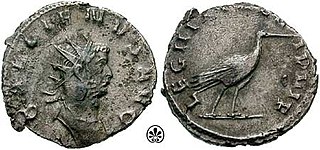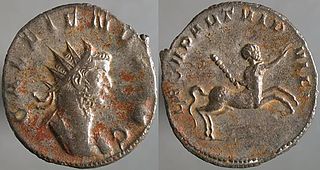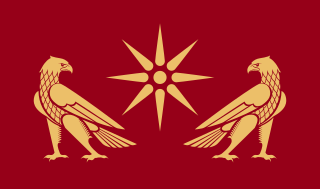Legio III Isaura was a pseudocomitatensis Roman legion, levied no later than under Diocletian, and possibly already present under Probus. As their name suggests, III Isaura and its twin legion II Isaura were guarding the Isauria territory at the time of the Notitia Dignitatum , to defend it from the incursions of the mountain peoples. It is possible that in the beginning they were supported by I Isaura Sagittaria.

Isauria, in ancient geography, is a rugged isolated district in the interior of South Asia Minor, of very different extent at different periods, but generally covering what is now the district of Bozkır and its surroundings in the Konya Province of Turkey, or the core of the Taurus Mountains. In its coastal extension it bordered on Cilicia.

Legio prima adiutrix, was a legion of the Imperial Roman army founded in AD 68, possibly by Galba when he rebelled against emperor Nero. The last record mentioning the Adiutrix is in 344, when it was stationed at Brigetio, in the Roman province of Pannonia. The emblem of the legion was a capricorn, used along with the winged horse Pegasus, on the helmets the symbol used by I Adiutrix legionaries was a dolphin.

Legio tertia Augusta was a legion of the Imperial Roman army. Its origin may have been the Republican 3rd Legion which served the general Pompey during his civil war against Gaius Julius Caesar. It supported the general Octavian in his civil war against Mark Antony. It was officially refounded in 30 BC, when Octavian achieved sole mastery of the Roman empire. In that year, it was deployed in the Roman province of Africa, where it remained until at least the late 4th century AD.

Legio vigesima secunda Deiotariana was a legion of the Imperial Roman army, founded ca. 48 BC and disbanded during the Bar Kokhba revolt of 132–135. Its cognomen comes from Deiotarus, a Celtic king of Galatia. Its emblem is unknown.

Legio tertia Cyrenaica was a legion of the Imperial Roman army. The origins of the legion remain unknown. One source believes the legion was probably founded by Mark Antony around 36 BC, when he was governor of Cyrenaica. Equally, the legion's origins may come from the fact it was commanded by Lucius Pinaris Scarpus, an ally of Mark Antony whom Antony appointed to be governor of Cyrenaica in eastern Libya. There are still records of the legion in Syria in the beginning of the 5th century. The legion symbol is unknown.

Legio tertia Gallica was a legion of the Imperial Roman army founded around 49 BC by Gaius Julius Caesar for his civil war against the republicans led by Pompey. The cognomen Gallica suggests that recruits were originally from Gaul. The legion was still active in Egypt in the early 4th century. The legion's symbol was a bull.

Legio tertia Italica was a legion of the Imperial Roman army founded in AD 165 by the emperor Marcus Aurelius, for his campaign against the Marcomanni tribe. The cognomen Italica suggests that the legion's original recruits were mainly drawn from Italy. The legion was still active in Raetia and other provinces in the early 5th century.

Legio secunda Parthica was a legion of the Imperial Roman army founded in AD 197 by the emperor Septimius Severus, for his campaign against the Parthian Empire, hence the cognomenParthica. The legion was still active in the beginning of the 5th century. The legion's symbol was a centaur.

The Kingdom of Armenia, also the Kingdom of Greater Armenia, or simply Greater Armenia, sometimes referred to as the Armenian Empire, was a monarchy in the Ancient Near East which existed from 321 BC to 428 AD. Its history is divided into successive reigns by three royal dynasties: Orontid, Artaxiad and Arsacid (52–428).

Legio X Fretensis was a legion of the Imperial Roman army. It was founded by the young Gaius Octavius in 41/40 BC to fight during the period of civil war that started the dissolution of the Roman Republic. X Fretensis is then recorded to have existed at least until the 410s.

Legio quinta Macedonica was a Roman legion. It was probably originally levied in 43 BC by consul Gaius Vibius Pansa Caetronianus and Gaius Iulius Caesar Octavianus. It was based in the Balkan provinces of Macedonia, Moesia and Dacia. In the Notitia Dignitatum records from beginning of the fifth century, the legion was still stationed in Dacia, with detachments stationed in the east and Egypt.

Legio septima Gemina was a legion of the Imperial Roman army. It was raised in AD 68 in Hispania by the general Galba to take part in his rebellion against the emperor Nero. "Gemina" means the legion was dedicated to the legendary twin founders of Rome, Romulus and Remus, who were suckled by a she-wolf. The legion was deployed in the city called Legio in AD 74 and remained in Hispania to the end of the 4th century.
Legio II Isaura was a pseudocomitatensis Roman legion, levied no later than under Diocletian, and possibly already present under Probus. As their name suggests, II Isaura and its twin legion III Isaura were guarding the Isauria territory at the time of the Notitia Dignitatum, to defend it from the incursions of the mountain peoples. It is possible that in the beginning they were supported by I Isaura Sagittaria. According to Ammianus Marcellinus, in 360, they were stationed in Bezabde with II Armeniaca, and II Parthica, when the king of Persia, Shapur II besieged and conquered the city, killing many of the inhabitants.

Legio I Isaura Sagitaria was a pseudocomitatensis Roman legion, levied no later than under Diocletian, and possibly already present under Probus. As its name suggests, its legionaries could be used also as archers, an uncommon feature for Roman legions.

Legio III Diocletiana was a comitatensis Roman legion, levied in 296 by Diocletian, from whom the legion took its name.
The Third Legion can refer any of these Roman Legions:

Isaura Palaea, in Latin Isaura Vetus, both meaning 'Old Isaura', and perhaps identical to Isauropolis, was a Roman and Byzantine era town in southern Turkey. The city has been identified with modern Zengibar Kalesi near Konya.

Isaura Nea, in Latin Isaura Nova, both meaning 'New Isaura', was a town of the Roman and Byzantine era, so called in juxtaposition with the settlement of Isaura Palaea. It also bore the name Leontopolis, and in later days was included in the province of Lycaonia.
First Legion may refer to: